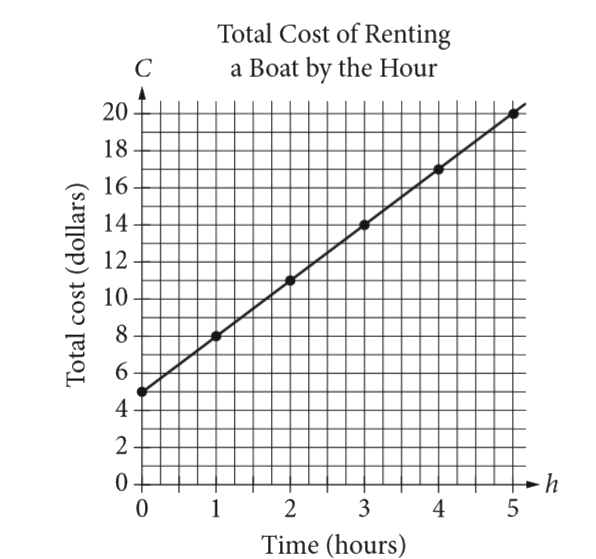The number of bacteria colonies h hours after the beginning of an experiment is given by the function C(h)=3h−2h+20. What does the number 20 represent in the function?
The final rate of growth, in colonies per hour.
The initial rate of growth, in colonies per hour
One less than the initial number of bacteria colonies
One more than the final number of bacteria colonies.
The correct Answer is:C
To determine what the number 20 represents in the function C(h)=3h−2h+20, we will analyze the function step by step.
Step 1: Understand the function
The function C(h) gives the number of bacteria colonies h hours after the beginning of an experiment. The components of the function include:
- 3h: This term represents exponential growth of the bacteria over time.
- −2h: This term indicates a linear decrease in the number of bacteria colonies as time progresses.
- +20: This is a constant term that we need to analyze.
Step 2: Calculate the initial number of bacteria
To understand what the constant 20 represents, we can find the value of C(h) when h=0 (i.e., at the beginning of the experiment).
C(0)=30−2(0)+20
Step 3: Simplify the expression
Now, simplify the expression:
C(0)=1−0+20=1+20=21
Step 4: Interpret the result
At h=0, the number of bacteria colonies is 21. Since the function C(h) gives us the number of bacteria colonies after h hours, the constant term +20 can be interpreted as follows:
- The initial number of bacteria colonies at h=0 is 21.
- Therefore, the number 20 represents one less than the initial number of bacteria colonies.
Conclusion
Thus, the number 20 in the function C(h) represents one less than the initial number of bacteria in the colonies.
Final Answer
The correct interpretation is:
C: one less than the initial number of bacteria in the colonies.
---
The function C(h) gives the number of bacteria colonies h hours after the beginning of an experiment. The components of the function include:
- 3h: This term represents exponential growth of the bacteria over time.
- −2h: This term indicates a linear decrease in the number of bacteria colonies as time progresses.
- +20: This is a constant term that we need to analyze.
To understand what the constant 20 represents, we can find the value of C(h) when h=0 (i.e., at the beginning of the experiment).
Now, simplify the expression:
At h=0, the number of bacteria colonies is 21. Since the function C(h) gives us the number of bacteria colonies after h hours, the constant term +20 can be interpreted as follows:
- Therefore, the number 20 represents one less than the initial number of bacteria colonies.
Thus, the number 20 in the function C(h) represents one less than the initial number of bacteria in the colonies.
The correct interpretation is:
C: one less than the initial number of bacteria in the colonies.
Topper's Solved these Questions
Similar Questions
Knowledge Check
- Question 1 - Select One
h(t) = −16t2 + 110t + 72
The function above models the height h, in feet, of an object above ground t seconds after being launched straight up in the air. What does the number 72 represent in the function?AThe initial height, in feet, of the objectBThe maximum height, in feet, of the objectCThe initial speed, in feet per second, of the objectDThe maximum speed, in feet per second, of the object - Question 2 - Select One

The graph above displays the total cost C, in dollars, of renting a boat for h hours.
What does the C-intercept represent in the graph?AThe initial cost of renting the boatBThe total number of boats rentedCThe total number of hours the boat is rentedDThe increase in cost to rent the boat for each additional hour - Question 3 - Select One
It was observed in an experiment that the number of bacteria doubles evey hour. It was found that the number of bacteria twelve hours from the start of observation was 40960. After how many hours from the start of the experiment would the number of bacteria has been one-fourth the final number of bacteria?
A11B10C8D6
The number of hours, H, needed to manufacture X computer monitors is given by the function H=kX+q, where k and q are constants. If it takes 270 hours to manufacture 100 computer monitors and 410 hours to manufacture 160 computer monitors, how many minutes are required to manufacture each additional computer monitor?
View SolutionA scientist studies Bacteria Culture A, which grows then percent every hour. Bacteria Culture A initially contained 200 microbes, and she models the growth using the equation n=200(m)h, where n is the number of microbes and h is the number of hours.
Q. What is the value of m in the equation ?View SolutionA scientist studies Bacteria Culture A, which grows then percent every hour. Bacteria Culture A initially contained 200 microbes, and she models the growth using the equation n=200(m)h, where n is the number of microbes and h is the number of hours.
Q. The same scientist also studies another culture, Bacteria Culture B, which grows 15% every hour. The two cultures began at the same time with the same number of microbes. After 20 hours, how many more microbes will becteria Culture B contain than Bacteria Culture A ? (Round your answer to the nearest whole number).View SolutionThe total number of electrons in 2.0 g of D2O to that in 1.8 g of H2O
View SolutionThe number of electrons lost in the following change is
Fe+H2O→Fe3O4+H2View Solution

